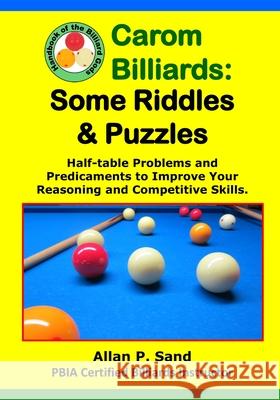Carom Billiards: Some Riddles & Puzzles: Half-table Problems and Predicaments to Improve Your Reasoning and Competitive Skills » książka
Carom Billiards: Some Riddles & Puzzles: Half-table Problems and Predicaments to Improve Your Reasoning and Competitive Skills
ISBN-13: 9781625052193 / Angielski / Miękka / 2015 / 150 str.
Carom Billiards: Some Riddles & Puzzles: Half-table Problems and Predicaments to Improve Your Reasoning and Competitive Skills
ISBN-13: 9781625052193 / Angielski / Miękka / 2015 / 150 str.
(netto: 87,38 VAT: 5%)
Najniższa cena z 30 dni: 91,50
ok. 16-18 dni roboczych
Dostawa w 2026 r.
Darmowa dostawa!
Test & Fine-Tune Your AIMING SYSTEMS with these Fixed Layouts
These Half-Table Carom Billiards layouts offer an excellent variety of table setups that show up in game after game. For Full-Table layouts, see the book Carom Billiards: MORE Riddles & Puzzles.
The layouts are designed to allow experimentation to try various cue ball speeds, spins, and angles. This provides significant personal competitive benefits:
Intellectual training - Evaluate the layouts and consider how many pathway options are available. Make sketches of paths and cue ball speeds & spins for the practice table. This increases your analytic and tactical skills.
Skills confirmation - As you attempt each path, your experimentation helps to determine whether it is viable (within your skills) or useless (too difficult or fantastic). This comparison between mental imagery and physical attempts helps determine the width and breadth of your abilities.
Skills advancement - If a path looks promising, but execution fails, work with various speeds/spins to discover what works. Several consecutive successes will add this to your personal library of competencies.
TABLE SETUP
Use donuts (paper reinforcement rings) to mark positions for the carom balls. These are available at any office supply store.
Place the first cue ball on the "A" ball position, the second cue ball on the "B" position, and the Red Ball on the dark ball position.
PLAYING RULES
Depending on your game preferences, use the appropriate scoring rules:
3-Cushion
Straight Rail
Balkline
One Cushion
For specific details, search on the World Wide Web for "carom billiards rules."
TABLE OPTIONS
Every table layout provides four (4) different ways to score points:
CB1 > Red > CB2
CB1 > CB2 > Red
CB2 > Red > CB1
CB2 > CB1 > Red
HOW TO STUDY
Start with armchair analysis. Look at each table layout and consider possible playing options. Imagine shooting your ideas, concentrating on the appropriate speed and spin. Make sketches and notes, as needed.
Alternately, take this book to your practice table, put the donuts down, and (without shooting anything), mentally figure out how many different ways you can play the shot.
Make notes of your ideas. If this is a printed book, use a pencil and sketch out pathways. Make sketches, and when you get to the practice table, give them a shot.
At the practice table, apply the paper reinforcement rings for the three ball positions. Think through the shot before you get down and stroke the cue ball.
When shots get close, experiment with different speeds/spins and angles until you can consistently score (3 of 4 attempts). This is how you become a tougher and more dangerous player.
CHALLENGES (for fun & profit)
For a change of pace, consider setting up a friendly competition among your buddies. Mutually select several of these layouts. Place the donuts on the table.
Use a round-robin format. Everyone shoots an agreed number of times (1, 3, or 5) per setup. Winner gets the pot, and another round begins.
+++++++++++
NOTES:
- Ball positions are not random. They are calculated to fall within a wide variety of common pathways.
- There are no hints or tips. Experimentation is encouraged.
- Test newly learned systems with these layouts.
- Test your abilities to predict the future.
+++++++++
FYI - there are two "Riddles & Puzzles" books:
- Carom Billiards: Some Riddles & Puzzles (half-table layouts)
- Carom Billiards: MORE Riddles & Puzzles (full-table layouts)
"











